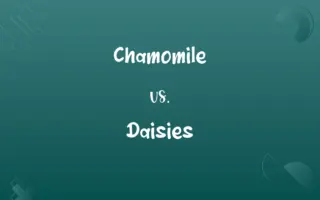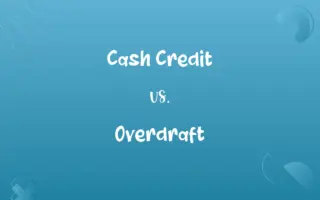Self-Pollination vs. Cross-Pollination: Know the Difference

By Shumaila Saeed || Published on January 31, 2024
Self-pollination occurs when a flower's pollen fertilizes itself, while cross-pollination involves pollen transfer between different flowers.

Key Differences
Self-pollination is a process where pollen from a flower's own anther is transferred to its stigma. This type of pollination does not require external agents like wind or insects. Cross-pollination, however, involves pollen transfer from the anther of one flower to the stigma of another flower, usually of a different plant, often facilitated by external factors like insects, birds, or wind.
Shumaila Saeed
Jan 31, 2024
In self-pollination, the genetic material is transferred within the same flower or between flowers of the same plant, leading to a genetically similar offspring. Cross-pollination, conversely, mixes genetic material between different plants, resulting in greater genetic diversity and potentially more resilient offspring.
Shumaila Saeed
Jan 31, 2024
Self-pollination is common in plants that are isolated or have limited access to pollinators. It ensures reproduction but at the cost of reduced genetic diversity. Cross-pollination, in contrast, is favored in diverse ecosystems and contributes to the evolution and adaptability of plant species by introducing genetic variation.
Shumaila Saeed
Jan 31, 2024
Self-pollinated plants are often more homogenous and stable in their characteristics, making them predictable for cultivation. Cross-pollinated plants exhibit more variation, which can be advantageous in adapting to changing environments or resisting diseases.
Shumaila Saeed
Jan 31, 2024
While self-pollination is efficient and guarantees seed production, it can lead to inbreeding depression over generations. Cross-pollination is more complex and requires specific mechanisms or agents for pollen transfer, but it enhances the long-term survival and evolution of plant species.
Shumaila Saeed
Jan 31, 2024
ADVERTISEMENT
Comparison Chart
Pollen Source
From the same flower or plant
From a different flower, often a different plant
Shumaila Saeed
Jan 31, 2024
Genetic Variation
Limited, as it involves one plant
Higher, involves two different plants
Shumaila Saeed
Jan 31, 2024
Dependence on Pollinators
Not required or minimal
Often requires pollinators like insects, birds, wind
Shumaila Saeed
Jan 31, 2024
Resulting Offspring
Genetically similar to the parent
Genetically diverse from the parents
Shumaila Saeed
Jan 31, 2024
Adaptability and Evolution
Lower adaptability due to less genetic diversity
Higher adaptability and evolutionary potential
Shumaila Saeed
Jan 31, 2024
ADVERTISEMENT
Self-Pollination and Cross-Pollination Definitions
Self-Pollination
Self-pollination is when a flower pollinates itself.
Peas often undergo self-pollination, producing offspring identical to the parent.
Shumaila Saeed
Jan 11, 2024
Cross-Pollination
Cross-pollination involves the transfer of pollen between different flowers.
Bees facilitate cross-pollination in apple orchards, enhancing genetic diversity.
Shumaila Saeed
Jan 11, 2024
Self-Pollination
Self-pollination involves transferring pollen within the same flower.
In greenhouses, tomato flowers often resort to self-pollination.
Shumaila Saeed
Jan 11, 2024
Cross-Pollination
Cross-pollination requires external agents like insects or wind.
Butterflies play a crucial role in the cross-pollination of many wildflowers.
Shumaila Saeed
Jan 11, 2024
Self-Pollination
It's a form of pollination where the pollen and stigma belong to the same flower.
Self-pollination in beans guarantees a stable crop yield.
Shumaila Saeed
Jan 11, 2024
ADVERTISEMENT
Cross-Pollination
Cross-pollination promotes genetic diversity among plants.
The vibrant colors of many garden flowers are a result of cross-pollination.
Shumaila Saeed
Jan 11, 2024
Self-Pollination
It occurs when pollen from a plant fertilizes the same plant.
Wheat plants can self-pollinate, ensuring seed production even without external pollinators.
Shumaila Saeed
Jan 11, 2024
Cross-Pollination
It occurs when pollen from one plant reaches another plant's flower.
Wind often aids in the cross-pollination of corn fields.
Shumaila Saeed
Jan 11, 2024
Self-Pollination
Self-pollination happens without genetic input from another plant.
Many orchids are capable of self-pollination, ensuring their survival in isolated conditions.
Shumaila Saeed
Jan 11, 2024
Cross-Pollination
It's the exchange of pollen between flowers of different plants.
Cross-pollination in almond trees is essential for nut production.
Shumaila Saeed
Jan 11, 2024
Self-Pollination
The transfer of pollen from an anther to a stigma of the same flower; autogamy.
Shumaila Saeed
Jan 11, 2024
Cross-Pollination
The transfer of pollen from an anther of a flower of one plant to a stigma of a flower of another plant of the same species. Also called allogamy, xenogamy.
Shumaila Saeed
Jan 11, 2024
Self-Pollination
The transfer of pollen from an anther of one flower to a stigma of another flower on the same plant; geitonogamy.
Shumaila Saeed
Jan 11, 2024
Cross-Pollination
Influence or inspiration between or among diverse elements
"Jazz is fundamentally the cross-pollination of individual musicians playing together and against each other in small groups" (Ralph de Toledano).
Shumaila Saeed
Jan 11, 2024
Self-Pollination
Pollination of a flower by its own pollen, in a flower that has both stamens and a pistil.
Shumaila Saeed
Jan 11, 2024
Cross-Pollination
(botany) fertilization by the transfer of pollen from an anther of one plant to a stigma of another.
Shumaila Saeed
Jan 11, 2024
Self-Pollination
Fertilization by transfer of pollen from the anthers to the stigma of the same flower
Shumaila Saeed
Jan 11, 2024
Cross-Pollination
(figurative) inspiration, stimulation, or influence between diverse elements.
Shumaila Saeed
Jan 11, 2024
Cross-Pollination
Fertilization by transfer of pollen from the anthers of one flower to the stigma of another.
Shumaila Saeed
Jan 11, 2024
Cross-Pollination
Fertilization by transfer of pollen from the anthers of one flower to the stigma of another
Shumaila Saeed
Jan 11, 2024
Cross-Pollination
Stimulating influence among diverse elements;
The cross-pollination of the arts
Shumaila Saeed
Jan 11, 2024
Repeatedly Asked Queries
How does cross-pollination differ from self-pollination?
Cross-pollination involves pollen transfer between different plants, unlike self-pollination.
Shumaila Saeed
Jan 31, 2024
Does self-pollination affect plant evolution?
Self-pollination can limit plant evolution due to reduced genetic variation.
Shumaila Saeed
Jan 31, 2024
Can a plant have both types of pollination?
Yes, some plants are capable of both self-pollination and cross-pollination.
Shumaila Saeed
Jan 31, 2024
What are examples of self-pollinating plants?
Examples include tomatoes, peas, and wheat.
Shumaila Saeed
Jan 31, 2024
What is the advantage of cross-pollination?
Cross-pollination increases genetic diversity, which can lead to stronger, more adaptable plants.
Shumaila Saeed
Jan 31, 2024
How do pollinators influence cross-pollination?
Pollinators like bees and butterflies are crucial for transferring pollen between plants in cross-pollination.
Shumaila Saeed
Jan 31, 2024
What is self-pollination?
Self-pollination is when a plant's own pollen fertilizes its flowers.
Shumaila Saeed
Jan 31, 2024
Can human intervention affect plant pollination?
Yes, human activities like agriculture and habitat alteration can impact both self- and cross-pollination.
Shumaila Saeed
Jan 31, 2024
Are self-pollinating plants dependent on pollinators?
Self-pollinating plants generally do not rely heavily on pollinators.
Shumaila Saeed
Jan 31, 2024
Is self-pollination common in nature?
Self-pollination is common, especially in environments where cross-pollination agents are scarce.
Shumaila Saeed
Jan 31, 2024
Are cross-pollinated plants better for biodiversity?
Yes, cross-pollinated plants enhance biodiversity by introducing genetic variation.
Shumaila Saeed
Jan 31, 2024
What are the downsides of cross-pollination?
Cross-pollination can be unpredictable and depends on external factors like the presence of pollinators.
Shumaila Saeed
Jan 31, 2024
Can self-pollination lead to weaker plants?
Over time, self-pollination can lead to weaker plants due to inbreeding.
Shumaila Saeed
Jan 31, 2024
What role does wind play in pollination?
Wind can be a significant agent in both self- and cross-pollination, particularly for certain grasses and trees.
Shumaila Saeed
Jan 31, 2024
How do environmental conditions affect self-pollination?
Harsh or isolated environments can favor self-pollination as a reliable form of reproduction.
Shumaila Saeed
Jan 31, 2024
Why is genetic diversity important in plants?
Genetic diversity helps plants adapt to changes and resist diseases and pests.
Shumaila Saeed
Jan 31, 2024
Are there any agricultural practices that favor self-pollination?
Yes, some agricultural practices, like controlled environments, may favor self-pollination for consistency.
Shumaila Saeed
Jan 31, 2024
How does climate change impact pollination?
Climate change can alter the timing and effectiveness of both self- and cross-pollination.
Shumaila Saeed
Jan 31, 2024
How does self-pollination ensure seed production?
Self-pollination guarantees seed production even in the absence of pollinators.
Shumaila Saeed
Jan 31, 2024
Does cross-pollination require specific plant structures?
Yes, certain plant structures and mechanisms facilitate cross-pollination.
Shumaila Saeed
Jan 31, 2024
Share this page
Link for your blog / website
HTML
Link to share via messenger
About Author
Written by
Shumaila SaeedShumaila Saeed, an expert content creator with 6 years of experience, specializes in distilling complex topics into easily digestible comparisons, shining a light on the nuances that both inform and educate readers with clarity and accuracy.








































































